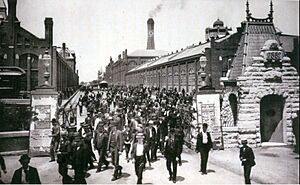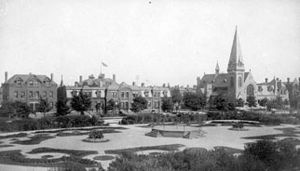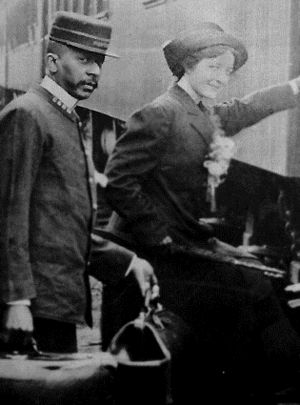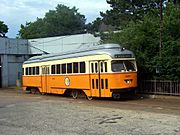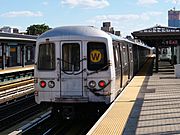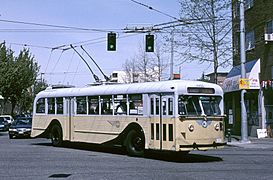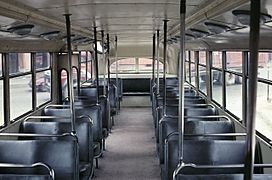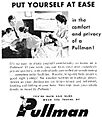Pullman Company facts for kids
| Industry | Rail transport |
|---|---|
| Fate | Absorbed by Bombardier Transportation (1987) |
| Successor |
|
| Founded |
|
| Defunct | December 31, 1968 (As Pullman Company) |
| Headquarters | Chicago, Illinois, U.S. |
|
Area served
|
United States/Worldwide |
| Products | High-speed trains Intercity and commuter trains Locomotives People movers Railroad cars Rapid transit trains Signalling systems Trams Trolleybuses |
The Pullman Company was a famous American company. It built special railroad cars, especially luxurious sleeping cars. George Pullman started the company in the mid-1800s. This was a time when railroads were growing fast in the United States.
Pullman became very powerful in making and owning sleeper cars. At its busiest, in the early 1900s, its cars carried 26 million people each year. It was like running "the largest hotel in the world" on wheels! The company also built thousands of streetcars and trolley buses for cities.
Pullman didn't just make the cars. It also ran them on most U.S. railroads. The company paid railroads to attach its cars to their trains. Later, the railroads ended up owning Pullman. A very important labor union, the Brotherhood of Sleeping Car Porters, was linked to the company. It was founded by A. Philip Randolph. This union became a powerful group for African-American rights in the 20th century.
After World War II, more people started using cars and airplanes. This led to the company's decline. Pullman stopped its main operations in 1968.
Contents
The History of Pullman Cars
After a train trip where he slept in his seat, George Pullman had an idea. He wanted to design a better passenger car. This new car would have comfortable beds for everyone. During the day, the top bed folded up. At night, it folded down. The two seats below it also folded to make a lower bed.
This new design was much better than older train cars. Curtains gave people privacy. There were also restrooms at each end of the car. The first Pullman car was built in Illinois in 1859.
Building a Luxury Travel Company
Pullman started his company in 1862. He built fancy sleeping cars. These cars had carpets, curtains, soft chairs, and even libraries. They offered amazing customer service. From 1867 to 1915, special paper wheels made the ride quieter and smoother.
The Pullman Company was once a very well-known name. But it is also remembered for a difficult time. In 1894, there was a big strike by its workers. This happened during a tough economic period. Pullman cut workers' hours and pay. But he did not lower the rent for their homes. This led to the strike. Workers joined the American Railway Union.
After George Pullman passed away in 1897, Robert Todd Lincoln became the company president. He was the son of Abraham Lincoln. In 1930, Pullman bought another company, Standard Steel Car Company. The new company was called Pullman-Standard Car Manufacturing Company. The company closed its factory in Chicago in 1955. Pullman stopped making passenger cars in 1982. Its remaining designs were later bought by Bombardier Transportation in 1987.
Pullman's Company Town
In 1877, a big railroad strike happened in the U.S. This led to stronger worker unions. It also made some employers think more about their workers' lives. George Pullman wanted to build a special town for his workers. He hoped to attract the best employees. He also wanted to keep bad influences away from them.
In 1880, George Pullman announced his plan. He would build a company town and factory. He expected to make money from the rent on the houses. But the town never made as much money as he hoped.
Life in the Town of Pullman
The company built the town of Pullman, Illinois. It was about 14 miles south of Chicago. George Pullman hired experts to design the town and its landscapes. He wanted to keep costs low and work fast. He used mass production methods whenever he could.
The buildings were made of red brick with stone trim. Inside, they had high ceilings and big windows. The walls were painted in light colors to make them cheerful. The town had a library, a theater, a hotel, a church, and a market. It also had a sewage farm, a park, and many homes.
The homes had modern features like gas, running water, and indoor plumbing. Garbage was collected regularly. By 1884, there were over 1,400 homes. By the next year, more than 8,600 people lived there.
A town agent was in charge of everything. This included street and building care, water, fire protection, and the hotel. All officials were chosen by Pullman himself. There were no elections, except for the school board.
The Town's Impact and End
The Pullman company town became famous. Many people praised Pullman's idea. One newspaper called it "the youngest and most perfect city in the world." But some critics thought it was too controlling. They said it was like a "benevolent, well-wishing feudalism."
During a tough economic time in 1893, Pullman cut wages and laid off workers. But he did not lower the rent or utility costs in the town. This led to the Pullman Strike in 1894. After the strike, the company town was never the same.
In 1904, a court ordered the Pullman Company to sell the town. They finally did so in 1907. Today, Pullman is a neighborhood in Chicago. It is also a special historical landmark. In 2015, it became a National Monument.
Pullman Porters: A Legacy of Service and Change
The Pullman Company was also known for its porters. These porters served first-class passengers in the fancy sleeping cars. George Pullman started hiring porters in 1868. He looked for people who were excellent at service. This led the company to hire mostly African-American men. Many of them were formerly enslaved people.
Pullman's choice was mainly about saving money. He paid the porters very little. This meant they had to rely on tips from passengers for most of their income. This helped the company make more money.
Even with low wages, being a Pullman Porter was seen as a stable job. It allowed many African-Americans to achieve a middle-class life. This was due to their hard work and saving money. They often used their earnings to help their children and grandchildren go to college.
Porters faced harsh treatment and disrespect from passengers and the company. In 1925, after many years of this, the porters formed a union. It was the first African-American labor union. A. Philip Randolph founded the Brotherhood of Sleeping Car Porters (BSCP). After years of effort, they won a fair contract in 1937. At its peak, the union had over 18,000 members.
The impact of Pullman porters went beyond the railroad. A. Philip Randolph used his union organizing skills to help start the Civil Rights Movement. Another Pullman porter, E. D. Nixon, helped organize the 1955 Montgomery Bus Boycott. Nixon used Rosa Parks' arrest to rally support. He asked a young minister new to Montgomery to lead the boycott: Martin Luther King Jr..
Pullman's Products: Trains and More
Pullman-Standard built many different types of rail vehicles.
Rail Vehicles Built by Pullman
| Model | Operator | Introduced | Withdrawn |
|---|---|---|---|
| Streetcars, including the PCC streetcar | Various cities | 1891 | 1951 |
| Steel interurban cars | South Shore and South Bend Railroad | 1926–29 | |
| Articulated rapid transit cars | Chicago Transit Authority | 1947 | 1985 |
| Skytop Lounge sleeping cars | Milwaukee Road | 1948–49 | |
| "Washboard" EMUs | New York, New Haven and Hartford Railroad | 1954 | 1983 |
| Passenger stock | Long Island Rail Road | 1955 | 1999 |
| Gallery cab and coach cars | Chicago and North Western Transportation Company | 1956, 1958–70 | |
| Lightweight, all aluminum Train-X | New York Central & New Haven | 1957 | 1970 |
| ACMU Cars | New York Central/Metro-North | 1962–65 | |
| Bluebird cars | MBTA Red Line | 1963 | 1994 |
| MP75 | Long Island Rail Road | 1963 | Converted to trailer coaches in the 1970s |
| Rapid transit cars | Chicago Transit Authority | 1964 | 1993 |
| "Airporter" cars | Cleveland GCRTA Red Line | 1967 | |
| Silverbird cars | MBTA Red Line | 1969–70 | |
| Comet I commuter coach | NJ Transit | 1970 | |
| Subway cars | New York City Subway | 1936–38 | |
| R46 | New York City Subway | 1975–78 | |
| CTC/BTC-1 coaches | MBTA Commuter Rail | 1978 | |
| Superliner | Amtrak | 1978–81 | |
| Gallery I-III series bi-level passenger cars |
-
A 1946 PCC streetcar in Boston.
-
A late 1970s R46 New York City subway car.
Pullman built streetcars from 1891 to 1951. It was one of only two U.S. companies that built the PCC streetcar. This was a standard type of streetcar used by many North American cities. Pullman built the first PCC car in 1934. But the first production cars were built in 1938.
Trolley Buses from Pullman
Pullman-Standard also made trolley buses. These are buses that get power from overhead electric lines. They built them from 1931 to 1952. The company made over 2,000 trolley buses. Most were for U.S. cities. Some were sent to Canada and South America.
The last trolley buses were built for Valparaíso, Chile, in 1952. Some of these Pullman trolley buses are still in use there today! In 2003, the remaining ones were named a National Historic Monument by the Chilean government.
-
A 1944 Pullman trolley bus preserved in Seattle.
Images for kids
-
A coach built in 1890 by Pullman for the B&O Royal Blue. It is now at the B&O Railroad Museum in Baltimore, Maryland.
-
Built in 1928, the 'Amundsen' reportedly carried Presidents Herbert Hoover, Franklin D. Roosevelt, Harry S. Truman and Dwight D. Eisenhower.


